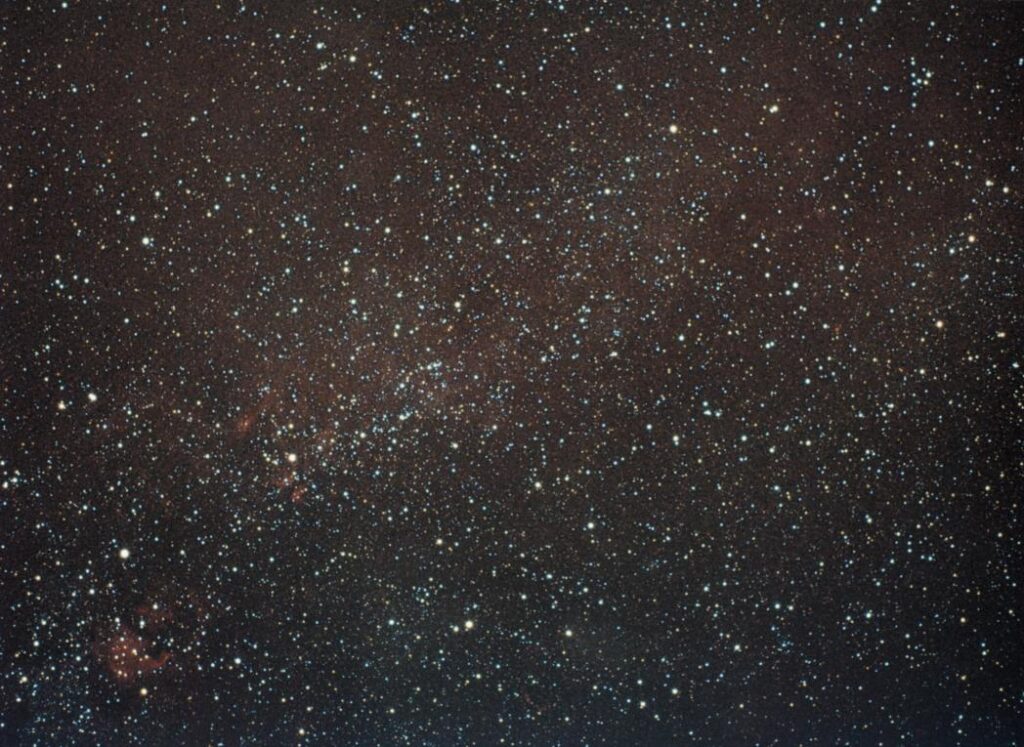Cygnus: The Swan (take 1)

| Object: | Cygnus, Vulpecula, and Sagitta |
| Location: | Narrowsburg, NY |
| Observer: | Roland Roberts |
| Time: | 21 Jul 2001 4:00 UT |
| Camera: | Pentax A3000, 50 mm f/2 lens |
| Film: | Kodak Elite Chrome II, ISO 200 |
| Exposure: | 4 minutes at f/4 |
This is my first attempt at film-based sky photography. Well, not exactly my first. I shot on roll of film in New York City just trying for star trails with the goal of finding where the sky fog limit was. However, I couldn’t tell the difference in any of the prints which all came out with a nice green sky. I attribute that to using Kodak Gold film and having had it developed someplace that couldn’t handle special requests. And then there was the roll of film I shot where I didn’t correctly engage the film on the take up roller while loading it in the dark, but let’s not discuss that now….
This shot comes with its own set of problems. I used slide film, Kodak Elite Chrome II, ISO 200. My camera, a semi-automatic 35 mm, seems to have developed a dislike for my cable release and would randomly terminate the exposure and start taking a new one. I ended up throwing out one 24-exposure roll and of the second roll I only had 5 shots come out worth keeping; only 3 of those were actually at the exposures I had planned. Additionally, because I failed to take a daytime picture at the start of the roll and because the first couple of frames were severely underexposed, the lab cut the slide right in the middle when mounting the slides.
Still, I was quite pleased with this one shot. Not perfect but good enough to be a big motivator for trying some more. The first picture captures the core of Cygnus along with Vulpecula and Sagitta. The low-resolution scan here makes a few features nearly disappear even though they are clearly visible on the film and print. In particular, the Veil Nebula is quite obvious on the print, but after scanning at low resolution and doing an HSV stretch to provide a darker background, it has pretty much disappeared.
Visible in this image (but unlabelled ’cause I deleted the labelled version, doh!):
- (the Swan), Vulpecula (the Fox), and Sagitta (the Arrows).
- Stars (2): Deneb Adige and Albireo.
- Planetary Nebula (1): M27 — the Dumbell Nebula.
- Supernova Remnant (1): NGC6992 — the Veil Nebula.
- Other Nebula(1): NGC7000 — the North American Nebula, IC5068 — the Pelican Nebula, IC1318A and IC1318B, and IC1311.
Search
.Archives
- May 2025 (3)
- October 2024 (1)
- May 2024 (2)
- April 2024 (3)
- September 2022 (5)
- April 2022 (1)
- January 2022 (3)
- December 2021 (4)
- September 2021 (3)
- July 2021 (1)
- January 2021 (1)
- November 2020 (2)
- October 2020 (2)
- September 2020 (2)
- August 2020 (5)
- July 2020 (1)
- November 2019 (2)
- September 2019 (1)
- August 2019 (2)
- September 2017 (1)
- August 2017 (1)
- September 2015 (3)
- August 2015 (2)
- June 2015 (5)
- May 2015 (3)
- May 2013 (2)
- January 2013 (1)
- December 2012 (2)
- September 2012 (1)
- June 2012 (1)
- May 2012 (1)
- October 2011 (2)
- September 2011 (2)
- April 2011 (2)
- March 2011 (10)
- January 2011 (8)
- November 2010 (2)
- October 2010 (1)
- September 2010 (3)
- August 2010 (2)
- July 2010 (1)
- June 2010 (1)
- April 2010 (3)
- February 2010 (3)
- January 2010 (3)
- December 2009 (6)
- November 2009 (3)
- October 2009 (7)
- September 2009 (8)
- August 2009 (4)
- July 2009 (1)
- June 2009 (2)
- May 2009 (2)
- April 2009 (7)
- March 2009 (1)
- February 2009 (6)
- January 2009 (4)
- December 2008 (4)
- November 2008 (3)
- October 2008 (11)
- September 2008 (4)
- August 2008 (5)
- July 2008 (5)
- June 2008 (2)
- April 2008 (4)
- March 2008 (18)
- February 2008 (9)
- November 2007 (1)
- October 2007 (3)
- July 2007 (3)
- April 2007 (1)
- March 2007 (6)
- February 2007 (3)
- December 2006 (3)
- October 2006 (4)
- September 2006 (1)
- July 2006 (5)
- May 2006 (10)
- April 2006 (9)
